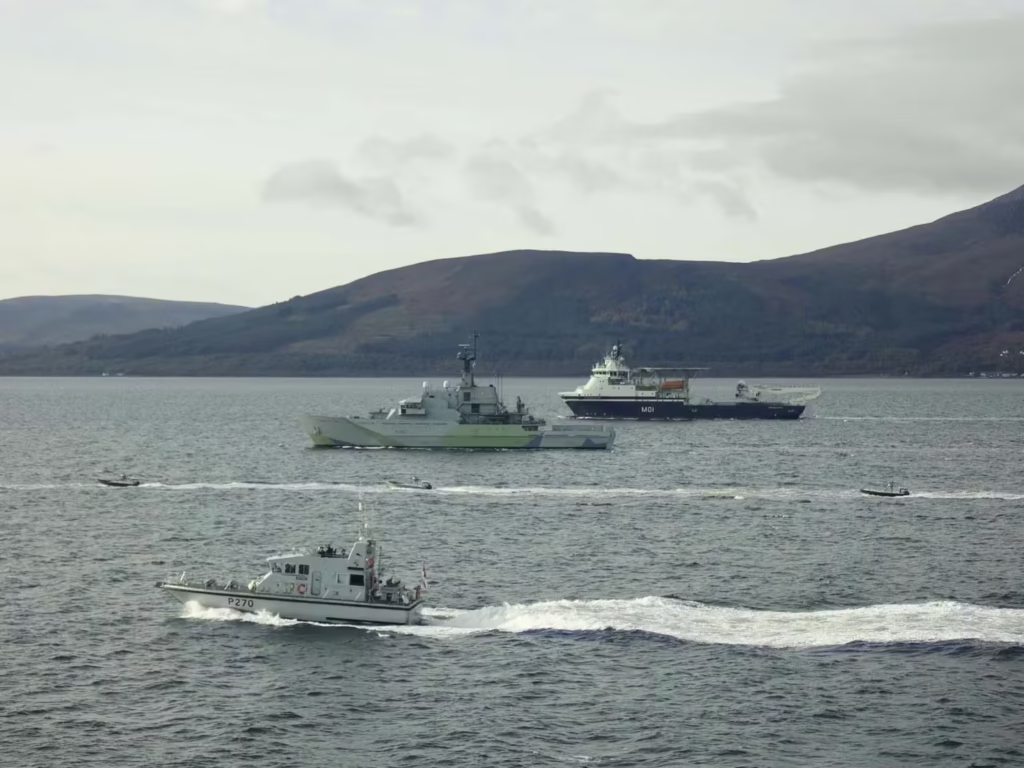5 uncrewed boats remotely piloted from 500 miles away surrounded HMS Tyne throughout a three-day demonstration off the Scottish coast, marking what the Royal Navy referred to as a milestone in its transfer towards a Hybrid Navy of crewed and uncrewed platforms.
The train, carried out by the Navy’s Disruptive Capabilities and Expertise Workplace (DCTO) and the Fleet Experimentation Squadron (FXS), simulated the escort of a warship utilizing a flotilla of seven.2-metre autonomous Rattler vessels.
The uncrewed boats have been managed from Patrick Blackett, moored in Portsmouth, whereas working in Scottish waters in coordination with HMS Tyne, HMS Stirling Fort, HMS Biter and a Merlin helicopter.
5 uncrewed boats, remotely piloted from over 500 miles away, surrounded HMS Tyne in a significant Royal Navy trial off Scotland, a key step towards a Hybrid Fleet of crewed and uncrewed vessels working collectively at sea. pic.twitter.com/avobMmoGmn
— UK Defence Journal (@UKDefJournal) November 1, 2025
Dwell information, video and sensor feeds have been transmitted to controllers aboard Patrick Blackett, permitting the Rattlers to carry out escort and surveillance duties in actual time. The Royal Navy mentioned the demonstration was the end result of months of trials, displaying how uncrewed floor vessels might work alongside conventional ships in future operations.
The undertaking was developed in collaboration with a consortium of small and medium-sized firms. Navy personnel have been immediately concerned within the design and testing course of to make sure the boats met operational necessities, in keeping with the Navy. Constructed on inflexible inflatable boat hulls, the Rattlers are fitted with autonomy techniques and modular payloads that may be tailor-made for missions comparable to reconnaissance, surveillance and payload supply.
Every boat is managed by a two-person workforce utilizing a transportable “plug and play” laptop computer system. The vessels can function independently or as a swarm, following pre-programmed mission profiles or, in time, functioning autonomously with out direct human management.
Commander Michael Hutchinson, who leads the Fleet Experimentation Squadron and instructions Patrick Blackett, mentioned within the press launch that “this can be a actually vital second for the Royal Navy as we progress in direction of a Hybrid Navy of crewed and uncrewed platforms.”
He added that the uncrewed floor vessels had been “constructed and developed at tempo, in a ground-breaking means, alongside a coalition of implausible native firms.” Hutchinson described the undertaking as “essentially the most thrilling of my profession,” including that the platforms would function each in assist of present warships and as a functionality in their very own proper.
“In recent times we have now seen the impact that autonomy and uncrewed techniques can have at sea, on land and within the air, particularly in Ukraine,” he mentioned. “Within the maritime area the impact has been exceptional, with easy, low-cost, one-way effectors used to defeat advanced and succesful warships and deny them freedom of manoeuvre at sea.”
He famous that uncrewed floor vessels are additionally getting used for reconnaissance, patrol and survey operations, making it “crucial that the Navy develop these techniques and prepare individuals with the talents to function them.”

Brigadier Jaimie Roylance, the Royal Navy’s Chief Expertise Officer, mentioned within the press launch that “this is a vital second within the historical past of the Royal Navy.” He referred to as it “the primary time we have now been in a position to area a succesful, mission-ready, deployable uncrewed system at sea” and the “first main success for the DCTO.”
Roylance praised the work of the FXS, Coastal Forces Squadron, Royal Marines and Military personnel, saying their efforts to develop the techniques and coaching “have been astonishing and accomplished in document time.” He added that whereas extra growth lies forward, “the broader consortium of SMEs we’re working with are as much as the duty.”

